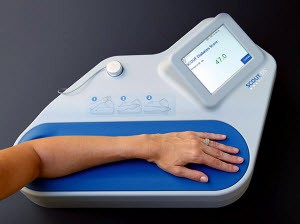There is no cure for type 2 diabetes, but it is possible for some people to put it into remission. Here’s what you need to know.
New diabetes screening tool: No needle required
Getting tested for diabetes usually means unpleasant fasting and uncomfortable blood tests. Now imagine a screening tool that needs neither one.

Let’s say you’re worried that you might have type 2 diabetes or prediabetes, due to your family history, because you’re overweight or because you get too little exercise. Usually, you’ll need a blood test to detect type 2 diabetes, often after fasting for at least eight hours. Now imagine a way to be tested without fasting or needles.
It’s an option that is already starting to become available in Canada. The Scout DS Diabetes Screen is a non-invasive tool that works like this: In a setting such as a pharmacy, a test operator (who could be a member of the pharmacy team) enters your age and gender into the device. You place your forearm on its surface, and a light scans your skin for the presence of certain biomarkers related to prediabetes and type 2 diabetes. In about 90 seconds, the results will pop up on a screen. If the results show an elevated risk, it’s recommended that you see your doctor for diagnostic blood testing.
The device has been cleared for commercial use by Health Canada. Says Paul Moreau of Miraculins, the Winnipeg-based biotechnology company that owns Scout DS: “We are working on making it widely available in pharmacy and grocery settings, and in workplaces for employee screenings. For now it’s being used in some targeted locations in southern Ontario, but we plan to roll it out more broadly to other parts of Canada in 2016.”
 According to the Canadian Diabetes Association (CDA), type 2 diabetes is a disease in which your pancreas does not produce enough insulin, or your body does not properly use the insulin it makes. As a result, glucose (sugar) builds up in your blood instead of being used for energy. If your blood sugar levels are higher than normal but not yet high enough for a diabetes diagnosis, you have prediabetes.
According to the Canadian Diabetes Association (CDA), type 2 diabetes is a disease in which your pancreas does not produce enough insulin, or your body does not properly use the insulin it makes. As a result, glucose (sugar) builds up in your blood instead of being used for energy. If your blood sugar levels are higher than normal but not yet high enough for a diabetes diagnosis, you have prediabetes.
“Diabetes is a big problem that affects people, and healthcare systems, worldwide,” says John Maynard, the researcher and engineer who led the Scout DS development team (and who has a family history of diabetes). “We felt a rapid, non-invasive approach to diabetes screening would be a great thing for people to be able to detect it either before it starts — prediabetes — or before it gets tougher to manage and complications develop.”
The CDA recommends that everyone over age 40 be tested for type 2 diabetes every three years, and that you should be tested more frequently if you have one or more of these risk factors:
- a parent, brother, or sister with diabetes
- health complications associated with diabetes
- high blood pressure
- high cholesterol or other fats in the blood
- polycystic ovary syndrome
- acanthosis nigricans (darkened patches of skin)
- any of these psychiatric disorders: schizophrenia, depression, bipolar disorder
- obstructive sleep apnea
or:
- You belong to a high-risk group (Aboriginal, Hispanic, South Asian, Asian, or African descent)
- You’ve given birth to a baby that weighed more than four kilograms (nine pounds) at birth or had gestational diabetes (diabetes during pregnancy)
- You’ve been diagnosed with prediabetes
- You’re overweight, especially if that weight is mostly carried around the waist
- You’ve been prescribed a glucocorticoid medication by a doctor


